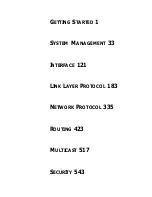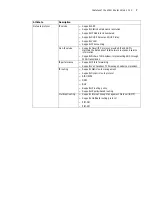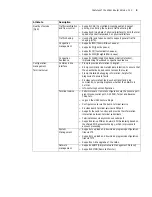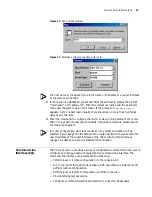
New Features of the 3Com Router 1.x
11
■
Combined with BDR, Frame Relay over ISDN can be taken as the backup
communication method for Frame Relay.
Multilink Frame Relay
The Multilink Frame Relay (MFR) feature introduces functionality based on the
Frame Relay Forum Multilink Frame Relay UNI/NNI Implementation Agreement
(FRF.16). This feature provides a cost-effective way to increase bandwidth for
particular applications by enabling multiple serial links to be aggregated into a
single bundle of bandwidth. MFR is supported on User-to-Network Interfaces (UNI)
and Network-to-Network Interfaces (NNI) in Frame Relay networks.
FR Compression
FR compression technology is used to compress the FR packets for the purpose of
effectively saving the network bandwidth and decreasing the network load, and
hence to implement data transmission over FR networks with high efficiency.
3Com Routers follow the FRF.9 standard for FR compression. FR compression can
achieve a significant effect on a FR line with low bandwidth. FR interfaces fall into
two categories, namely, point-to-point interface and multipoint interface.
Bridge
Bridges are a type of network devices that connect LANs at the data link layer for
data transmission among them. For some small or remote networks, a bridge can
reduce the network maintenance cost and free the network terminal subscribers
from making special settings for the devices. In addition, its network connection is
no difference from a HUB.
3Com Routers support transparent bridging and are compatible with IEEE 802.1d.
The routers support the STP and bridging functions defined in IEEE 802.1d and
support bridging on the links encapsulated with PPP, HDLC, X.25, or Frame Relay,
as well as bridging on VLAN sub-interfaces and BDR. Furthermore, the routers can
implement multi-port binding and load sharing.
IP Count
IP count implements accounting on the incoming and outgoing packets as well as
the packets denied by the firewall on the routers. When implementing IP count,
whether the packets match the count list rules and whether the packets are
denied by the firewall, are two standards by which the router sorts the
bidirectional packets for count. When making data statistics, both the number of
packets and the total bytes are recorded.
Virtual Router
Redundancy Protocol
(VRRP)
Virtual Router Redundancy Protocol (VRRP) is a fault tolerant protocol. Normally,
the default route set for a host in a network takes the GW route of the network as
the next hop. Through the default route, the host can carry out the
communications with the external networks. If the GW route fails to work, all the
hosts that take it as the next hop on the segment will be unable to communicate
with the outside. VRRP can fulfill the router redundancy by assigning multiple
routers into a router group. Thus, whenever a member fails to work, a backup
router will take up the work of the failed router and thus can ensure the normal
communications between the hosts on the network and the outside.
Summary of Contents for 3036
Page 1: ...http www 3com com 3Com Router Configuration Guide Published March 2004 Part No 10014299 ...
Page 4: ...VPN 615 RELIABILITY 665 QOS 681 DIAL UP 721 ...
Page 6: ...2 ABOUT THIS GUIDE ...
Page 7: ...I GETTING STARTED Chapter 1 3Com Router Introduction Chapter 2 3Com Router User Interface ...
Page 8: ...4 ...
Page 16: ...12 CHAPTER 1 3COM ROUTER INTRODUCTION ...
Page 34: ...30 ...
Page 60: ...56 CHAPTER 3 SYSTEM MANAGEMENT ...
Page 98: ...94 CHAPTER 6 DISPLAY AND DEBUGGING TOOLS ...
Page 110: ...106 ...
Page 114: ...110 CHAPTER 8 INTERFACE CONFIGURATION OVERVIEW ...
Page 158: ...154 CHAPTER 10 CONFIGURING WAN INTERFACE ...
Page 168: ...164 ...
Page 188: ...184 CHAPTER 13 CONFIGURING PPPOE CLIENT ...
Page 192: ...188 CHAPTER 14 CONFIGURING SLIP Router ip route static 0 0 0 0 0 0 0 0 10 110 0 1 ...
Page 248: ...244 CHAPTER 16 CONFIGURING LAPB AND X 25 ...
Page 320: ...316 ...
Page 330: ...326 CHAPTER 20 CONFIGURING IP ADDRESS ...
Page 362: ...358 CHAPTER 21 CONFIGURING IP APPLICATION ...
Page 374: ...370 CHAPTER 23 CONFIGURING IP COUNT ...
Page 406: ...402 CHAPTER 25 CONFIGURING DLSW ...
Page 408: ...404 ...
Page 452: ...448 CHAPTER 29 CONFIGURING OSPF ...
Page 482: ...478 CHAPTER 30 CONFIGURING BGP ...
Page 494: ...490 CHAPTER 31 CONFIGURING IP ROUTING POLICY ...
Page 502: ...498 ...
Page 508: ...504 CHAPTER 33 IP MULTICAST ...
Page 514: ...510 CHAPTER 34 CONFIGURING IGMP ...
Page 526: ...522 CHAPTER 36 CONFIGURING PIM SM ...
Page 528: ...524 ...
Page 532: ...528 CHAPTER 37 CONFIGURING TERMINAL ACCESS SECURITY ...
Page 550: ...546 CHAPTER 38 CONFIGURING AAA AND RADIUS PROTOCOL ...
Page 590: ...586 CHAPTER 40 CONFIGURING IPSEC ...
Page 599: ...IX VPN Chapter 42 Configuring VPN Chapter 43 Configuring L2TP Chapter 44 Configuring GRE ...
Page 600: ...596 ...
Page 638: ...634 CHAPTER 43 CONFIGURING L2TP ...
Page 649: ...X RELIABILITY Chapter 45 Configuring a Standby Center Chapter 46 Configuring VRRP ...
Page 650: ...646 ...
Page 666: ...662 ...
Page 670: ...666 CHAPTER 47 QOS OVERVIEW ...
Page 700: ...696 CHAPTER 49 CONGESTION MANAGEMENT ...
Page 706: ...702 CHAPTER 50 CONGESTION AVOIDANCE ...
Page 707: ...XII DIAL UP Chapter 51 Configuring DCC Chapter 52 Configuring Modem ...
Page 708: ...704 ...
Page 762: ...758 CHAPTER 52 CONFIGURING MODEM ...
















































